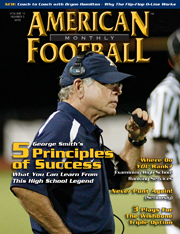AMERICAN FOOTBALL MONTHLY THE #1 RESOURCE FOR FOOTBALL COACHES
|
|
Article Categories
|
The Ratings Game - Today’s High School Ranking Servicesby: Steve Dorsey© More from this issueBy the time Christmas rolls around this year, Jamie DeMoney will have scoured more than 2,000 DVDs of high school football games sent to him by coaches nationwide. During the course of the upcoming 2010 season, Dallas Jackson will speak to an average of nearly 200 coaches a month.
DeMoney and Jackson work for different entities, but all of their work and effort is aimed at one common goal – determining which high school football team is the best in America. Last year, they reached the same conclusion when unbeaten Don Bosco Prep of Ramsey (NJ) was crowned the national champion for the first time.
DeMoney of PrepNation.com and Jackson of RivalsHigh.com agreed that Don Bosco Prep earned the recognition as No. 1 in the nation. They were not alone in their assessment. So did USA Today and MaxPreps. ....The full article can only be seen by subscribers.
Subscribe today!

|
|
|
NOT A SUBSCRIBER?
Subscribe
now to start receiving our monthly magazine PLUS get INSTANT
unlimited access to over 4000 pages of 100 percent football coaching
information, ONLY available at AmericanFootballMonthly.com!
|
|
|
HOME
|
MAGAZINE
|
SUBSCRIBE
|
ONLINE COLUMNISTS
|
COACHING VIDEOS
|
Copyright 2026, AmericanFootballMonthly.com
All Rights Reserved






